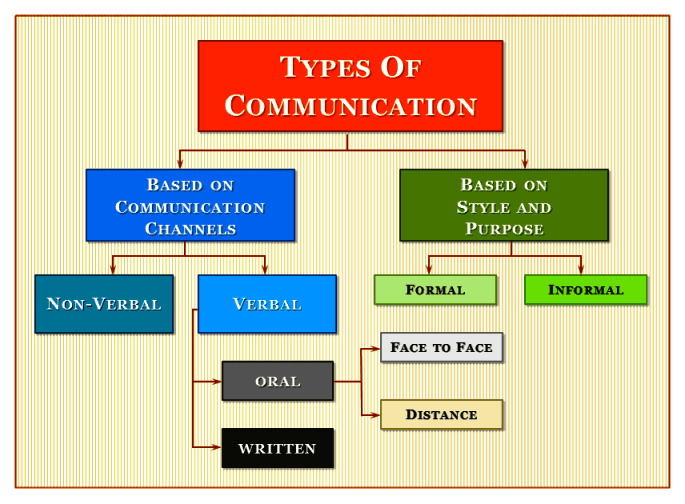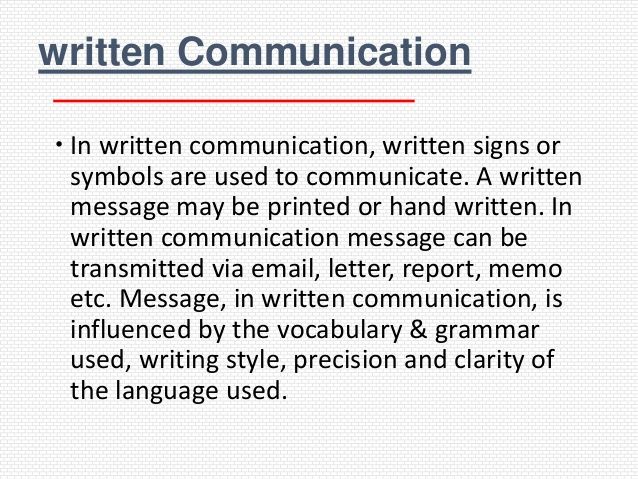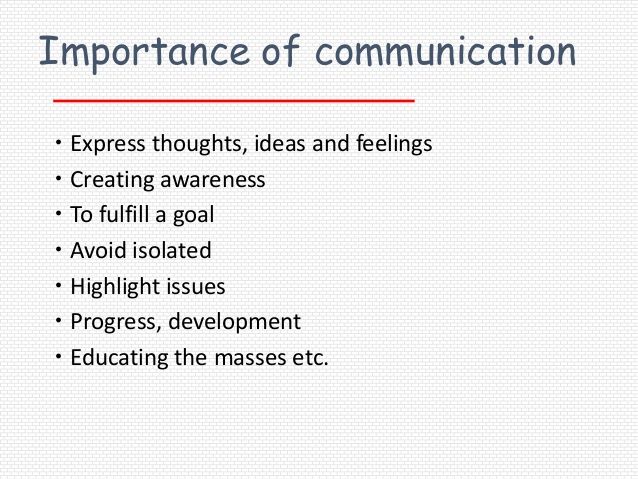
- Introduction to Communication Method
- What is Communication?
- Sorts of Communication Method
- Oral Communication (Face-to-confront)
- Oral Communication (Distance)
- Written Communication
- Non-verbal Types of Communication
- The whole Communication interaction can be isolated into the accompanying seven parts
- Assessing Your Communication
- Significance of Communication
- The extent of Communication Method
- Advantage and Disadvantage
- Pre imperatives
- Conclusion
- By definition, Communication is a two-way method for conveying data as considerations, thoughts, assessments, or guidelines between at least two people to construct an agreement.
- The style of Communication for the most part fluctuates starting with one individual then onto the next. During the Communication cycle, one can utilize numerous mediums/channels/modes/strategies to pass on his message.
- In any case, the Communication interaction doesn’t rely just upon the source that creates the data or transfers it. All things being equal, it likewise relies upon the medium utilized and how the recipient deciphers the message. We should initially comprehend the course of Communication with which we impart:
- It is: Directed through a pre-decided channel. For example, an enormous number of your associations inside your calling, monetary Communication (from and to your bank, loan bosses, debt holders, and so on), and lawful articulations are instances of formal Communication. Additional tedious that non-formal Communication, as it follows a specific Communication convention.
- Indeed, even in instances of oral articulations (in gatherings, courses, and so forth), regularly upheld by Written Communication can give documentation proof of the oral discussion. (This Written Communication could be pretty much as basic as a minutes-of-meeting, to as mind-boggling as a definite recording.)
- Thought about a solid wellspring of data. (So when you get a legitimate notification from your bank, you better consider it!). Formal Communication shapes the center of our expert lives (however not all proficient Communication is formal). Subsequently turning into a specialist in this sort of Communication is vital to proficient progression and achievement.
- Start by explaining the motivation behind your Communication.
- Regardless of whether you utilize an oral or Written articulation, consistently follow a clear-cut construction that can be effortlessly perceived by your crowd.
- Keep your tone open, proficient, and amicable.
- End by re-repeating what you hope to cause through this Communication: explanation on your position, replies to questions, a source of inspiration, and so on Likewise explain any limitations that apply to this Communication (like secrecy, time-limit for reaction, and so on)
- At long last, thank your crowd for their tuning in. (This functions admirably for Written Communication as well.)
- Unconstrained and free-streaming, with no proper convention or design. Subsequently, this sort of data is additionally less dependable or precise.
- A Communication channel that fans out like quickly, as there are no conventional standards to observe.
- Generally oral, with no documentation proof. Because of this, many subvert the worth of casual Communication, naming it simple “tattle”.
- Regardless of its disadvantages, casual Communication is thought of as “easy to understand” and thus offers tremendous benefits when utilized shrewdly. For example, consider this model where an organization is served by 3 unique caterers.
- Workers might become mindful of the timings of administration, rules, and guidelines through a conventional Communication conveyed by the organization of the board.
- In any case, they will become mindful of the favored caterer of the day through casual Communication from companions and associates. This sort of Communication consequently serves well when you need to control or support positive suppositions, thoughts, and articulations, without causing them to appear as though they’ve been “push onto” by senior administration.
- Improves with training. The more you practice mindfulness, the more control you will have over your oral articulations.
- Is dynamically alive! This intends that despite every single past practice, oral Communication offers you a present-second an open door to tune, reconsider, repudiate and fix what you express. It is henceforth the most remarkable kind of Communication and can work possibly in support of you with each articulation.
- Draws in your crowd more than different sorts of Communication. The audience (or a crowd of people) frequently hopes to talk back to you with oral Communication, empowering two-way Communication more than some other channel.
- Continuously meet the eyes of your crowd with certainty, conviction, and transparency.
- Practice before a mirror to consummate your tone and articulations, so they suit the message you need to pass on. They two features regularly convey more than your words do.
- Work on utilizing pretend. This implies that in any event, when you practice before a mirror, openly ask yourself, “Am I prepared to get this message with this tone and articulation?” If you’re not persuaded, your crowd will not be all things considered. So practice again until you take care of business.
- Intentionally draw in your crowd’s investment. This is the strength of this kind of Communication, so never allowed your oral articulation to be a one-way tirade to yourself. You can do this by posing inquiries, hearing their point of view, and empowering the articulation of groundbreaking thoughts.
- At last, become an attentive person. A viable oral communicator talks, yet in addition effectively pays attention to his crowd.
- Give higher need to your tuning in. Whenever you neglect to tune in, you will see that numerous individuals endeavor to talk simultaneously, subverting the worth of this type of Communication.
- Talk somewhat more slowly than you would in the eye-to-eye Communication. This will ensure that you stay mindful of the inconspicuous subtleties of your tone, and the has the opportunity to get a handle on what you convey.
- Continuously re-emphasize what you get when you tune in. This sort of Communication misses the non-verbal signs that you would get in the eye-to-eye Communication (that can show unpretentious articulations like resentment, cordiality, receptivity, mockery, and so forth) So reword what comprehend and affirm that this is without a doubt what the other party additionally intended to convey.
- Where proper, wear your agreeable face happily all the rage and eyes. Feel this well-disposed face. Your tone will consequently pass your transparency and receptivity on to the next individual. (This may not be proper assuming you hope to convey a notice on the telephone, so guarantee that your face suits your message.)
- At last, back this up with Written Communication where conceivable. The plan is to affirm the detract from the Communication so all gatherings are in total agreement. This seems OK in any event, for a casual call with your companion – maybe you can send a fast instant message to re-emphasize that it was so pleasurable to address him, and afterward affirm the last call-for-activity.
- Years and years prior, Written Communication relied upon the dependable old postal worker as we wrote to individuals who were far away. Every so often, this additionally incorporated the proper note or lawful notification from the bank, property manager, business client, and so forth What an unexpected then that this kind of Communication has now assumed control over each part of our reality!
- Consider it, in the event that you club the absolute Written Communication you draw in within a day – the instant messages you send over your extravagant versatile, your Facebook and Twitter updates, individual and expert messages, hell, even the web journals you compose – it would far outperform some other verbal Communication you appreciate. Right? It checks out then to be an outright expert at this kind of Communication. Recorded underneath are 3 principles that can assist you with arriving.
- Follow a reasonable design so your Communication isn’t out of control. This can incorporate a short presentation, plan, message body, and end. The keenness and adequacy of your Communication lies in the way you’re ready to catch this design in your method of Communication (email, instant message, speedy notice via web-based media, and so on)
- Explain the setting of your Communication where conceivable. This may seem like pointless excess for an innocuous instant message. In any case, you’d be astounded at how much innocuous (Written) Communication arrives at some unacceptable eyes and ears. So take care to guarantee that your setting is sensibly clear, regardless of who the beneficiary is.
- Continuously decide in favor of alert. There are not many cases when Written Communication is simply formal (addressed to proficient companions and seniors or outsiders), or casual (addressed distinctly to your nearby companion/family circle). All the more frequently, if falls between these two modes. Henceforth, play protected by adjusting a semi-formal tone, keeping your Communication clean (in language and articulation), and open (without culpable any gathering). Accept us when we say that it’s much better to have your companions consider you a “firm” communicator, as opposed to having your manager see you as a “hostile” communicator!
- This kind of Communication is more unobtrusive, yet undeniably more remarkable. It incorporates the whole range of actual stances and signals, tone and speed of the voice, and the mentality with which you convey.
- In the beyond a couple of many years, non-verbal communication specialists have uncovered how the stance you embrace, the hand signals you support, and different features of your actual character influence your Communication. It is advantageous to put in a couple of hours coming up to speed on essential non-verbal communication signals, so you don’t incidentally send blended messages in with your emotions and discourse. You can likewise utilize this to help your message, making it more significant.
- However, notwithstanding everything that these specialists say to you, there will be times when the non-verbal communication you are intended to adjust is in finished difference with how you feel (like utilizing a “well disposed of” pose when you inside feel undermined or scared). Subsequently, non-verbal Communication is best when these.
- What you say with your words.
- What you share with your stances and signals. (Nonetheless, these can be figured out how to communicate the right message).
- What you feel inside you, and thus impacts the unpretentious message you feel constrained to share outside you.
- As may be obvious, (1) and (2) can be learned with a smidgen of training. Be that as it may, (3) must be intentionally constructed so you continually adjust yourself to what you need to communicate.
- At the point when you need your companions to consider you an amicable individual, it is because you like and care for individuals.
- Whenever you need your group to consider you a solid Leader, it is because you truly assume liability for yourself and the group.
- Whenever you need your friends, seniors, and others to pay attention to you, it is because they are persuaded that you will pay attention to them and component their musings and sentiments.
- Expanded mindfulness
- Better information
- Further developed abilities
- More members and more inquiries
- Bigger reaction rates
- Changes in conduct Expanded media inclusion
- We speak with others pretty much consistently in practically every climate, working environment, house, or some other spot. Communication turns out to be exceptionally important when we need to assemble a solid relationship with the other individual. It is additionally fundamental while sharing thoughts, dealing with a group, assigning liabilities, and significantly more. If Communication isn’t successful, we won’t establish an extraordinary connection, possibly we are introducing data to a huge gathering or giving a slight head gesture in any understanding.
- Communication is the way to achievement in many fields, and having great relational abilities without a doubt assists us with prevailing in our vocations. It can make us look somewhat phenomenal from others while contending as a task competitor. Additionally, it is one of the center prerequisites in deals and promoting. Further developing relational abilities takes time and consistent practice, however, it genuinely deserves contributing our time and standing separated from the group.
- Pernment record of message
- more preparation time
- message can come across easy
- feedback slower and more difficult
- message is impersonal
- get to know each other
- feedback is instant
- quick and accurate
- no record kept
- confusion is message isn’t clear
- time consuming
- powerful tool
- more reliable then oral expressions
- unaware of body language
- may reveal more then intended
- can be miss interpreted
- reaches a large audience
- easier to remember
- doesn’t contain a lot of information
- miss interpret message
Introduction to Communication Method:
For any business proficient, his disposition plays a vital part to play in how his message is deciphered. A timid or exhausted demeanor may give the data that the message doesn’t have any significance or you are not kidding about conveying the message. A positive, energetic, and liberal demeanor from the speaker takes the focal point of the audience members back to him.
What is Communication?
Specialized Methods:
An associated group and an associated association in this day and age is the main way we can accomplish more noteworthy things. Associations and relations are worked with a trade of musings and data. Communication fills in as a significant component in building these associations and commitment between individuals. Communication is a vital ability and craftsmanship. There are four distinct ways we speak with others. Regardless type of Communication we pick, it is critical to have the right goal to interface with the other individual.
Sorts of Communication Method:
Formal Types of Communication Skills
This sort of Communication is additionally alluded to as “true Communication” and covers the range of verbal articulations that address a proper need.
Underneath, we give you straightforward tips to dominate in your demeanor and calling.
Casual Communication:
Casual Communication is shockingly famous, and alluded to as “the (informal) grapevine”. This is done regularly by listening in on others’ conversations data. Truth be told, it is this sort of Communication that frees you up to informal yet provocative data.
Casual Communication is
Note: In current times, interpersonal organizations from “informal” sources (like your own Facebook and Twitter channels, LinkedIn, and so forth) are strong wellsprings of casual Communication and are frequently used to shape general assessment.

Oral Communication (Face-to-confront):
Up close and personal oral Communication is the most perceived sort of Communication. Here, what you express comes straightforwardly from what you talk about. Once more, this can be formal or casual: with your loved ones, in a conventional gathering or workshop, at work with your associates and chief, inside your local area, during proficient introductions, and so on.
This sort of Communication
For better face-than face Communication,
Oral Communication (Distance):
Distance (oral) Communication has made the world a more modest and more open spot. Cell phones, VOIP, video-conferencing, 2-way online courses, and so on are largely present-day developments of distance Communication, taking its demeanor to the following inconspicuous level. What’s more in this kind of Communication, your manner of speaking and speed of conveyance take need over different articulations.
For successful oral Communication over distance,
Written Communication:
Non-verbal Types of Communication:
Features are reliable in your Communication
For example,
The whole Communication interaction can be isolated into the accompanying seven parts:
Sender: Here, the shipper conceptualizes the thoughts or discussion to be passed on to the beneficiary.
Encoding: After that, the shipper begins the encoding system, where the source interprets the thought into a message utilizing words or non-verbal means.
Message: Once the encoding is done, the shipper concludes the message to be sent utilizing a reasonable medium.
Communication Channel: The source then, at that point, chooses the channel or mechanism of Communication to send the message to the beneficiary. A shipper should pick an appropriate channel to really and accurately decipher the message to the beneficiary.
Receiver: The recipient gets the message and attempts to comprehend it in the most ideal manner.
Decoding: The recipient then, at that point, interprets the shipper’s message and attempts to unravel the genuine implying that the source is attempting to clarify through the message.
Feedback: Finally, the collector recognizes the shipper’s message and offers the reaction. This guarantees the shipper that the beneficiary has effectively gotten the message and perceived the data, anything the source has explained with the message.

Assessing Your Communication:
It is essential to keep a beware of how your Communication is being seen. Is the right message getting passed in the correct way to the perfect individual? Assuming your Communication is casual, and the message was casual as well, then, at that point, the individual who conveys it can introduce it in a way that would sound natural to him, knowing completely well that the message is harsh (slow to comprehend) in nature. In any case, on the off chance that it is a proper discussion, the Communication should be in an organized and cleaned manner. Any assessment on Communication needs to check whether there have been any obvious enhancements in the accompanying regions −
Significance of Communication:
The extent of Communication Method:
Communication is fundamental in all aspects of our human existence. The extent of Communication is wide and unavoidable. Individuals are some way or another occupied with Communication from support to the grave. Nobody can spend even a day without Communication. The extent of Communication are given as follows:
Communication in private life:
Communication is firmly connected with all aspects of human existence. We rely upon Communication from doing our different exercises from daybreak to sunset. No one can pass his/her routine without the use of Communication. It is an Important a vital part of our own life. Everyone needs to speak with various individuals and associations day by day.
Communication in public activity:
Human is social creatures and everyone in the general public are connected. Business Communication has assumed an essential part in this friendly opportunity of individuals. The presence of Communication assists individuals with sharing their distresses, satisfaction and so forth We are living in an incorporated society since we are on human development. In public activity, individuals need to foster social servitude. Communication helps us in creating and fortifying this social servitude.
Communication in the state issues:
The existence of a state can’t run without the progression of Communication. Business Communication assumes an essential part for various the capacity of the state by the various methods of Communication. Without Communication, the state neither can regulate its different wings nor can keep up with associations with the other area of the planet. The entire world has transformed into a worldwide town because of progressive changes in Communication.
Advantage and Disadvantage:
Writen advantage
Written disadvantage
Oral advantage
Oral disadvantage
Body language advantage
Body language disadvantage
Visual advantage
Visual disadvantage

Pre imperatives:
Convey data, thoughts, suppositions, sentiments, and imaginings, utilizing a growing jargon; structure talk so thoughts can be perceived by others; talk plainly and adjust approaches to addressing crowd and circumstance; utilize non-verbal techniques to communicate thoughts and draw in with the audience.
Conclusion:
Taking everything into account, it is vital to continuously recall the significance of Communication in an association. The strategies for Communication you pick could as it were representing the deciding moment the administration design of your association and could likewise influence your relationship with clients, on the off chance that not selected cautiously.




